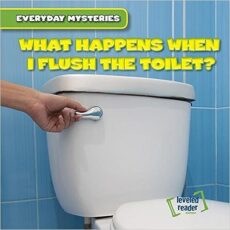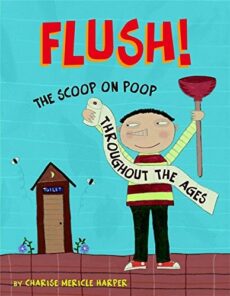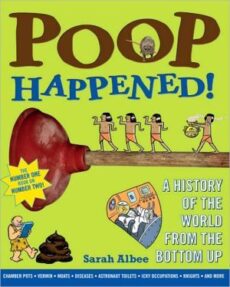Books
Where Does My Poo Go?

In this excellent picture book for younger learners, curious children will learn about sewage and what happens to it. With age-appropriate text and bright, colorful illustrations that depict each step of the sewage cycle, the author discusses topics from the “battle of the bugs” (bacteria) in the sewage plant to the eventual recycling of sludge as farm fertilizer and biomass fuel.
What Happens When I Flush the Toilet? (Everyday Mysteries)

One person uses more than 20,000 sheets of toilet paper each year! Follow this and other waste through the process of sewage treatment in this leveled text. This accessible description of waste management is accompanied by full-color photographs and a simple graphic organizer that aids comprehension for emergent readers.
Toilet: How It Works

Where does human waste go, and how is it made safe? With engaging text and clear illustrations, award-winning author David Macaulay takes readers on a tour of underground sewers, a municipal water treatment plant, and septic systems.
Flush! The Scoop on Poop Throughout the Ages

Few books on sewage for primary-grade children take a historical approach. These clever rhymes and cartoon illustrations highlight “fun facts” from the past about sewage disposal.
Sewers Stink: How Does Waste Go Down?

Discover how sewer systems work in this fact-filled introduction to wastewater treatment. Full-color photos allow readers to follow the journey that wastewater takes through the pipes beneath our feet. Includes a timeline, glossary, index, suggested books and websites, and critical thinking questions.
Flush: Treating Wastewater

This lively explanation of wastewater treatment takes readers through each step of the process, from the flush of the toilet until the water is ready to be used again. Interesting details will intrigue young readers: What does it smell like in the treatment facility? What are some unusual things (toys, money, reptiles) that find their way into the sewer system? Diagrams, photographs, a glossary and lots of “fun facts” make this an appealing book for middle-grade readers.
Water/Wastewater Engineer (21st Century Skills: Cool STEAM Careers)

Readers learn about the daily work of a wastewater engineer, and about how Science, Technology, Engineering and Math apply to this career path. Also available in Kindle edition.
Toilet, Bathtubs, Sinks and Sewers

The author takes readers on a trip through time as the history of human sewage treatment is discussed. One British archeologist observed, “There is no truer sign of civilization in culture than good sanitation. A good sewer implies as much as a beautiful statue.” A bibliography and webliography are included.
How Do Sewers Work? (STEM Waterworks)

This book discusses how sewer systems have worked in the past and how they currently operate in the present. Included are descriptions of septic systems, open sewer systems, and pipe design.
Poop Happened! A History of the World From The Bottom Up

From ancient Greek devices to medieval moats filled with sewage to astronauts' space toilets, dealing with raw sewage has been a fact of human life. This book focuses on the problems caused by lack of sewage treatment in various eras of history, the public-health challenges created by urbanization (including epidemics of cholera), and how the need for improved sewage treatment led to urban wastewater facilities. An engaging combination of social history and engineering progress over time.
